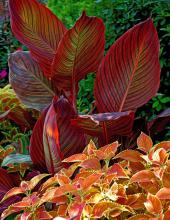Information Possibly Outdated
The information presented on this page was originally released on March 22, 2007. It may not be outdated, but please search our site for more current information. If you plan to quote or reference this information in a publication, please check with the Extension specialist or author before proceeding.
Design monochromatic color schemes like a pro
By Norman Winter
MSU Horticulturist
Central Mississippi Research & Extension Center
When I was in high school, kids loved to confess they had mono. Only teenagers can make an affliction trendy. Now that I'm a mature adult, and I would like to recommend mono to all my friends again. This time, it's a different kind of mono: monochromatic.
Mention the topic of designing beds of color for the landscape and gardeners' hearts start racing. There is some perceived magic to creating a professional bed with colorful flowers. Consider your last trip to a paint department.
Remember what you did that day. You picked out several cards, chips or slips with colors. Most likely the cards or swatches each had several shades of the same color. You may have actually used two or three colors from the same card.
If you did this, you would have been using a monochromatic color scheme. In other words, you were using blends of the same colors. Some might say that is how guys get dressed for church on Sunday.
The monochromatic color scheme is a foolproof way to not make a mistake in the landscape. It is also absolutely guaranteed to make you look like you knew what your were doing. In fact, many people in your neighborhood will suspect you broke down and hired a professional landscaping firm.
Color used in this scheme also creates spaciousness because it is not broken or interrupted by another color.
Even knowing now that we are talking about blends of single colors, you may be wondering where to start. A good starting place would be your favorite color. This is the real you; it's a color you are passionate about.
If you think single-color plantings are boring, then you better get that thought out of your head. You may opt for blends of the same color, but this doesn't mean they all have to be of the same flower. You need to plan to use as many different heights, shapes and textures as possible.
Great combinations can even be made using only foliage. Consider Tropicanna canna and Rustic Orange coleus. This combination provides hot colors and a tropical-looking display all summer. You could even add some bi-colored marigolds like Bolero or Safari.
One of my favorite monochromatic gardens feature Blazin Rose iresine with Oompah coleus. This planting provided a great change in textures and patterns, but basically the same colors in softer hues of reds, pinks and greens.
Consider how dazzling a planting can be by using Sparkler violet cleome with its exotic, spider-like blossoms and a height of 3 to 4 feet. In front of the cleome, use Salsa salvia in the same shades, only darker and richer. Then in front, plant some ground-hugging, spreading petunias.
In this planting you have differing heights -- tall, medium and prostrate. There are differing flower structures -- delicate, long stamens, spikiness from the salvia and the round from the petunia.
Even when designing in blends, don't forget about the possibilities of using flowers that offer more than one color.
No matter where you start on a color wheel -- hot side or cool side -- you can rest assured that there are flowers available to create your own personal blend and design.









